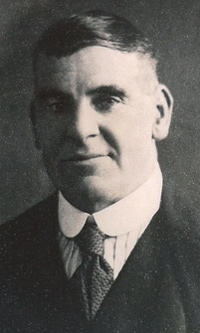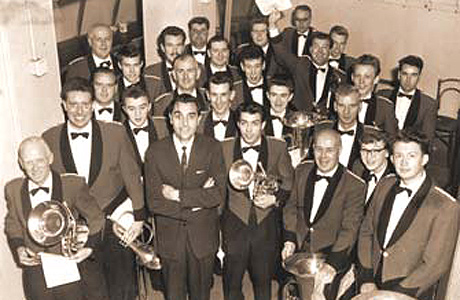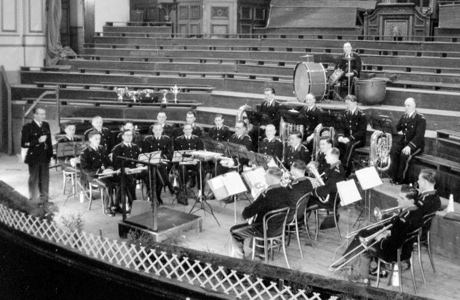4BR Time Team - Five Minute Wonders
10-Oct-2009Tim Mutum delves into the history books to recall the short, but spectacular banding lives of Ferodo, Cammell Laird and Crossley Carpet Works Bands.
One of the most detailed and scholarly books on brass banding is that edited by Trevor Herbert.
Published in 2000 by Open University Press, “The British Brass Band – A Musical and Social History” is a collection of studies on aspects of the banding movement.
The works band
I rather chuckle at the title of Chapter 2: “What’s Wrong with Brass Bands? - Cultural Change and the Band Movement, 1918 - c.1964”, thinking that the author, Dave Russell, really needed a book on the subject.
Early on he discusses all too briefly the issue of the works band.
Up to about 1930 works bands were either the products of individual paternalistic employers, the most well known of which was John Foster, or limited liability companies with a pronounced interest in social welfare.
Russell went on to say: “Perhaps beginning as early as the late 1930s, but certainly marked from the early 1950s, a rather more obviously commercial spirit seemed to underpin the desire to support bands.”
Silver spoons
He adds: “The period was littered with bands which were born with, or quickly given, silver spoons, and went rapidly into the championship class, only to disappear as costs mounted and the return, both social and economic, diminished.”
Sourcing information on three bands that fall into this category has been quite challenging.
However, research has revealed that they all, in their relatively short life span, certainly made an impact on the brass band scene.
However, as you read the following accounts, you might also like to reflect on the words of the late, and great, conductor George Thompson: “Works bands are built on sand: the subscription bands are built on rock.”
 Ferodo Works Band (1951 – 1958)
Ferodo Works Band (1951 – 1958)
An entrepreneur with the rather spectacular name of Herbert Frood formed the Ferodo Company in 1897.
In need of a catchy brand name to move the company forward he rearranged the letters of his surname to coin the word ‘Ferodo’ and soon set about building his company organisation in Chapel–en–le–Frith in the Peak District of Derbyshire, by inventing everything from asbestos brake pads to the first bullet proof clothing.
Behest
In 1951, at the behest of the management at the factory, a band was established - the Ferodo Works Band.
The late Bill Skelton, one of the best horn players of his day, and who first went to Belle Vue in 1927, was one of the ‘name’ players in the band. He later said it was one of the happiest bands he played with.
The company offered generous retainers and therefore attracted good players. In addition to Skelton, two former Black Dyke principals, Willie Lang and Bernard Bygraves joined the ranks, and Ferodo made its contest debut in Nottingham in 1952 under the direction of Fred Mortimer.
Succeed
That the management wanted the band to succeed became apparent with the appointment of George Hespe as Musical Director in 1953.
Hespe was aged 53 at the time, and had served in the Army as band boy and bandmaster between 1914 and 1933. He then turned his hand to conducting brass bands and for a time he also played tuba in the BBC Northern and Hallé orchestras.
Hespe's compositions included the march, ‘Kinderscout’, the trombone solo ‘Melodie et Caprice’ (sometimes anglicised to 'Melody and Caprice') and, most notably, the suite, ‘The Three Musketeers’, adopted as the test piece for the Belle Vue Championship in 1953.
Immediate
His impact was immediate – the band winning the Leicester Band Festival on Easter Monday.
Bill Skelton recalled his impressions of Hespe: “He was a marvellous, considerate man with the welfare of all his bandsmen at heart. Everything was perfection. We were the busiest band in the country. When we toured the accommodation was all first class. It was a young band – I was one of the oldest in it – and we were very adaptable, we could play anything.”
Spectacular
Ferodo’s contesting victories at the highest level were spectacular given the short life of the band itself.
The band came 3rd at the Grand Shield in 1953, and went on to come runner up at the British Open the following year. The band qualified for the National Finals in 1954 too (after coming runner up at the Midland Regional) – coming 6th off the number 2 draw on ‘Sovereign Heritage’. It was their only appearance at London.
The startling success of their Open victory of 1955 seemingly heralded a new major contesting force, as in 1956 they added the prestigious Edinburgh Festival title.
That was the high water mark though – fourth place at Belle Vue later that year was followed by their last appearance in Manchester in 1957 when they came out of the prizes. They were never seen at the contest again, although their winning performance of 1955 was later recorded.
Small story
There is one other small story to relate about Ferodo’s. Again it comes from Bill Skelton, who told of the night Mr Hespe couldn’t make a rehearsal. “Young Elgar Howarth turned up. He was what you might call a whizz kid. I remember he asked me if I could give him a bit more – I always reckoned I had a big tone, you know, and he wanted more, so I really let rip. Startled the life out of him it did.”
The year was 1957.
A year later the company disbanded the band for what was termed ‘economic reasons’.
The company had worked out that in seven years they had spent £70,000 more than the band had earned.
Cammell Laird Works Band (1957 – 1972)
The Cammell Laird Works Band was originally a combination of brass and reed. It was based in Birkenhead and all the players were employed by the ship building and ship repairing company of that name.
Not surprisingly, it was formed to provide music for what is always the proudest moment of a shipyard’s life, the launching of a newly built vessel.
The band dates from 1957 but whether that was the year of its formation or when it went all brass is not clear.

The rising James Scott and Cammell Laird
Respectable
However, in 1958 Rex Mortimer became musical director in addition to his main role with Fodens Band. In that year they entered their first competition, at Blackpool, and were placed a respectable seventh.
In 1959 the band secured the Fourth Section North West title, going on to win the National title itself in London. The start of a remarkable ascent to the very top echelons of British banding had begun.
In 1960 James Scott, then principal cornetist at Munn and Felton’s Band, was appointed bandmaster. James was at the peak of his playing career so this appointment was surprising.
The answer
An earlier article on 4barsrest about the life of James Scott provides the answer.
James says that he felt the time was right. In the spring of 1960 a letter arrived from the managing director of Cammell Laird asking if he would be interested in moving to become the musical director of the band.
After a great deal of thought – it was a gamble with no guarantee of success - he decided to take the plunge, as his desire to conduct had to be met at some stage.
He moved back north where he began what was to become a successful conducting career and, at the same time, gained valuable experience as a trumpet player with the major northern symphony orchestras.
The first few months were not the success James Scott had hoped.
Apprenticeship
The band was in the Third Section when he first joined them as bandmaster and Rex Mortimer was still professional conductor – James still thinks of it as his apprenticeship into the world of conducting.
Rex stayed a couple years and then it was left to James and gradually they began to improve.
In 1961 the band won both the Second Section North West Area and repeated their 1959 success by winning the National title in London too. Within four years the band had reached the Championship Section.
Stable team
James Scott attributed the success that followed to the fact that the membership of the band remained stable throughout the mid 1960s, with the exception of a couple of policemen who moved on through their police work. The band was a team.
The band won the Championship Section North West Area for the first time in 1964 and James Scott led them to their first appearance in the National Finals later that year.
Drawn 24th and last band to play on Gilbert Vinter’s ‘Variations on a Ninth’ they played far beyond their expectations and took 4th place. A year later, they repeated their North West victory, going onto London where they were runners-up behind Fairey.
Further visits to the National Championships in London followed, as the band added two further runner up placings in Blackpool plus a third in subsequent years.
In 1966 they were again placed fourth, and although they failed to gain a place in the 1967 and did not qualify in 1968, in 1969 James Scott led them to sixth place.
Final visit
The band’s final visit to the Royal Albert Hall was in 1970 after they won the North West Area for a third and final time. Despite the diluted field of rivals due to the World Championships, the band could not finish in the prizes. It was their last appearance at a major contest.
The band’s appearances at the British Open started in 1962 and ended in 1966 without them ever getting a mention in the prizes.
Decline
By the early 1970s shipbuilding was in decline and the band’s future became uncertain. In April 1972 it was tersely announced that the band had been closed down, the instruments and uniforms called in and future engagements cancelled.
A few years later James Scott had this to say, “The firm didn’t realise what they’d got – they were Philistines. Shipbuilding began to decline and they finished the band – said they couldn’t afford to run it. It was very sad”.
Crossley Carpet Works Band (1950 – 1969)
The origins of the band date back to December 1949 when fifteen workers at the Crossley factory near Halifax and two others, provided the music for the firm’s works carol service.
From that nucleus the band quickly became established aided by generous support from the company, winning its first contest in 1951 – the Fourth Section Area contest.

Ready to take the stage: Crossley Carpets ready for a contest performance
Quality
Like many a band it secured a quality conductor, this time in the shape of John Harrison who joined in 1952, and who became the driving force behind the band’s subsequent successes.
Harrison had conducted Brighouse & Rastrick although he was only musical director for a year, whilst his major playing success had been with Cresswell Colliery where he played cornet and soprano.
He left Crossley in 1955 but returned in 1958. During the 1960s he continued to conduct Crossley until its demise, and from 1964, was also professional conductor for a time at Cory, commuting from Halifax.
There was to be no further lower section Area titles for the band, but promotion through the sections meant that by 1953 they were competing in the Championship Section against the likes of Black Dyke and Brighouse.
Royal Albert Hall
In 1955 Crossley Carpet Works Band were competing in the Nationals at the Royal Albert Hall, courtesy of coming runner up at the Yorkshire Area.
Harrison, having left earlier in the year after the Area success, Willie Wood took them to the Final. It was the sign that the band had arrived in the ‘big time’, and help retain. Their new found status quality players such as Bernard Bygraves, previously of Brighouse and Black Dyke (and Ferodo as mentioned previously) were persuaded to join.
Reduction
Eventually, this led to a large reduction in the number of players employed by Crossleys, and by the early 1960s only about 20% of the band were employed by the company.
Crossley was now a force in Yorkshire, coming third at the Area in 1959 and 1961, winning the title in 1962 and coming runner up in 1964.
Great
They were placed third at the Nationals in 1961, and in 1962 went one better finishing second to CWS (Manchester), beaten only by one of the truly great contest wining performances on Verdi’s overture ‘The Force of Destiny’.
Their last appearance at London in 1964 saw them drawn 16 on ‘Variations on a Ninth’ – coming out of the prizes.
Their first appearance at the British Open came in 1956, although the band had failed to win the Grand Shield in the previous few years. The ‘one off’ appearance under Willie Wood saw them finish out of the prizes, but they returned in 1962 (following their Area win) and were placed fourth.
The band continued to appear at Belle Vue until 1968, but never again came in the prizes.
Ceased contesting
By 1969 the band had ceased contesting. It was overdrawn at the bank by £1,000 and only a few of the players worked for Crossleys. Furthermore, the parent - company at that time was in critical talks for a merger with a major rival.
In its edition of 28th June 1969, British Bandsman reported that the band had been wound up by the directors who, through company press officer Willa Mooje, also stated that it was not company policy to create work for musicians.
This brief survey covers just three of the bands that had such short lives.
There were others including the John White Footwear Band (Rushden, 1954 – 1957) and Clayton Aniline Works Band (near Manchester, 1943 – 1956).















